The world trade and retail industries have undergone an unprecedented transformation in recent years. One of the industries with the fastest growth is ecommerce, which has inspired a whole generation of business owners and promoted large-scale manufacturing by small and medium-sized businesses. How? People are moving away from brick-and-mortar establishments and online shopping due to the development of internet purchasing platforms, briefly called as ‘ecommerce websites’.
E-commerce has made it possible to lower barriers and increase customer-manufacturer interaction E-commerce has ushered in new prospects for traders and consumers with simple-to-use mobile apps and sophisticated store catalogs. Virtual stores on e-commerce platforms have facilitated the growth of millions of businesses and increased employment prospects.
By 2023, e-commerce will account for 22% of all worldwide retail sales, with more than $6.5 trillion in sales. Selling on one of the best ecommerce sites globally will be an excellent option if you want to improve sales and cut costs, and sellers can reach more clients in both domestic and international marketplaces.
So, which online shopping platform is the best for retailers to invest in? With the usage of smartphones, today’s technology has improved quickly, making internet purchasing for consumers a seamless process.
What are ecommerce websites?
By definition, an eCommerce website enables you to purchase and sell physical goods, digital products, or services online. It’s a business concept that incorporates online sales transactions, and this format is followed by almost every online shopping website, large or small.
ECommerce websites are places where you can make purchases over the internet.
FACTORS THAT DETERMINE THE SUCCESS OF AN ECOMMERCE WEBSITE
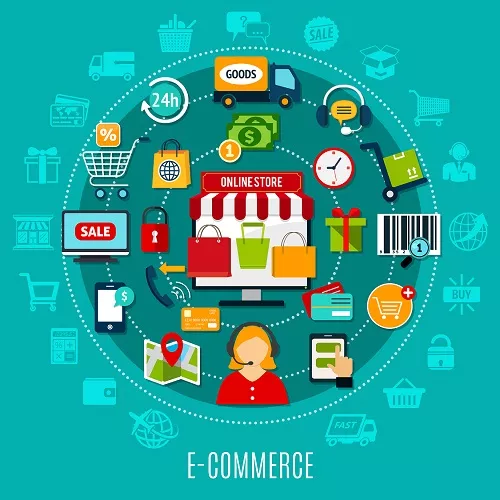
- Responsive Design
Over half of all web traffic worldwide comes from mobile devices (excluding tablets) (Statista, 202). No matter what device consumers use to access your site, you want to make buying as simple as possible for them. You can lose out on many sales if your eCommerce site isn’t mobile-optimized. It’s crucial to have a responsive eCommerce site that looks beautiful on all types of devices if you want to make it easier for customers to purchase from your store. Choosing the appropriate theme can make building a responsive eCommerce site simple because most eCommerce systems come with mobile-optimized articles.
- Visually Appealing Design
Although it’s doubtful that your eCommerce website design will appeal to every person who visits it, there are still several things you can do to improve the aesthetic appeal of your site. Keep in mind that your eCommerce website serves as your first impression.
- Product Pictures: Customers that visit your eCommerce store use the product photos to decide whether or not to make a purchase. The use of attractive and high-quality product photos is crucial for this reason.
- Images of the product in use are crucial because you want potential customers to be able to envision themselves using your product. Having a role model in mind makes this much simpler.
- Colors and fonts: These elements of your website’s design are equally crucial. Everyone has seen a website that appears to have been around since the early 1990s. Please don’t do it unless that’s your schtick.
- Keep your eCommerce website design clean and minimal, using no more than two colors. Additionally, you should pick two complementary fonts—one for headings and one for body copy. You can stay with a single typeface to keep things even simpler.
- Accessibility
Another crucial component of an attractive and well-designed website is accessibility. From the QA and UAT testing business StarDust, here are ten great suggestions for improving accessibility:
- Utilize an accessible content management system (CMS).
- Use headers to divide up your material
- Give your photos alt-text tags
- Use tables for tabular data, descriptive titles in link titles, high contrast colors, property label text fields when designing forms for accessibility, keyboard navigation, closed captions, and text alternatives for dynamic content like embedded videos and GIFs, and accessibility testing to verify your site’s accessibility.
- Easy-to-Use Navigation: The navigation of your website consists of the main menu, the on-site search bar, the filters, the product category pages, and the content of your footer.
- Because the goal of navigation is to make it simple for customers to find what they’re looking for, your navigation flow should be as condensed as possible, minimizing the number of paths a user must take.
- Bonus: Because search engines can better crawl your site with well-designed navigation, it will help with SEO and make it easier for customers to find what they want.
- Outstanding user experience:
Everything we’ve just covered is part of user experience (UX), but it goes a little farther than that. Design thinking, an iterative process used to learn the activities users take on an app or website, is a technique used by UI/UX specialists.
The finest UI/UX designers employ the following six digital design thinking best practices to make the best eCommerce sites:
- Give users navigational cues to help them navigate your site.
- Provide feedback to let visitors know what’s happening (like a confirmation page or email after taking a certain action.)
- Include thoughtful automation to reduce friction
- Make an emotional appeal
Create a smooth user journey that keeps visitors engaged
- Trust Signals
How do you tell if the website you’re reading is trustworthy? When making an online purchase, you most likely use a credit card or a payment method like PayPal that is directly linked to your bank account.
Although you can contest bogus accusations, is it preferable to stay out of that situation altogether?Most customers seek trust indicators to determine whether they can trust your website with their sensitive personal data.
There are some easy things you can do to calm their fears:
- Include contact details like a mailing address, email address, and phone number.
- Provide a return policy.
- Proudly display your compliance and security technology badges.
- Share client testimonials, reviews, and other forms of social proof.
The following qualities are the most important ones to consider when choosing among the many options.
- Serviceability/Pin Code Reach
This is the most crucial consideration when choosing an eCommerce company to shop with. The top people are, without a doubt, those who ship or deliver to your specified locations. An eCommerce business with a wider reach will probably ship to most places, so you won’t have to worry about looking for alternatives if you move or need to send something to a loved one.
- Goods and Services
Each eCommerce company and platform provides a unique selection of goods and services. The ideal eCommerce platform eliminates the need to navigate between apps by offering a wide range of services and advantages in one location. Some of these platforms also offer services for creating online stores.
- Delivery Mechanisms
The term “delivery mechanisms” refers to the entire system, including storage, transportation, and communication, that every eCommerce company uses for routine deliveries Miscommunications between an online marketplace for trade, and its users can be a significant source of unhappiness It’s critical to determine whether the business or platform can deliver a range of products securely and reliably. Waiting for a defective product wouldn’t be a good idea!
- Delivery Time
In today’s market, quick shipment is crucial. Over 3-5 days, they start to get anxious. Fast-track deliveries from an online retailer to ensure happy customers and fewer cancellations. Verify the anticipated delivery date before selecting the best choice for you.
- Tracking Visibility
Order tracking visibility is essential for the consumer to have a great post-purchase experience. To track orders more openly, the eCommerce company must offer real-time order tracking with automatic periodical updates. Every stage of delivery must be communicated to the customer.
- Delivery Proof
Not all deliveries are successful. The greatest eCommerce business will have a clear strategy and mechanism for sending proof of delivery, allowing for the documentation of customer complaints and holding delivery workers accountable for the product’s state at the time of delivery.
- Returns Administration
It’s only sometimes guaranteed that you’ll enjoy the items you get; some are intended for testing, while others may need to be revised. In these situations, the ideal eCommerce company has a strong returns management system, where a pick-up time is set, and the company ensures the package follows its original path back to the business.
World’s Best Ecommerce Websites
Amazon
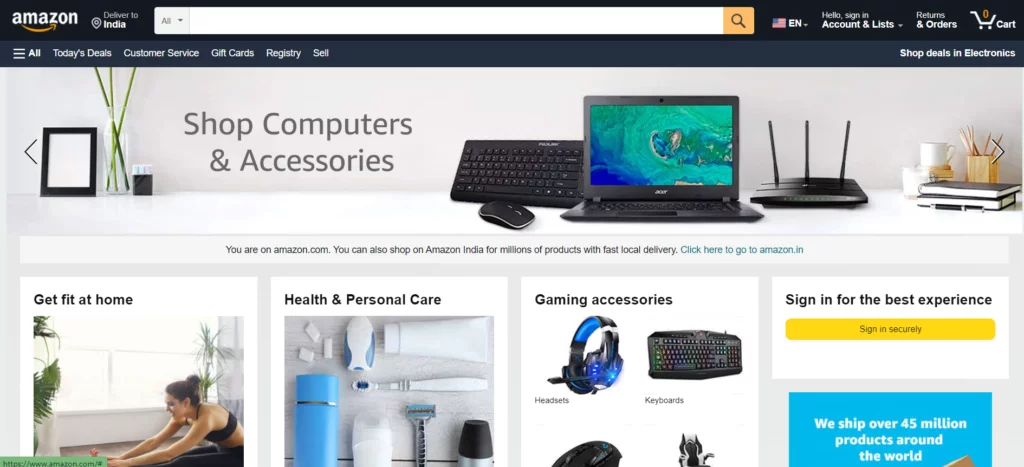
- Established: 1994
- Headquarters: Seattle, Washington, USA
- Monthly unique visitor: 524.47 million visits
An American technology business called Amazon was established in 1994. The business was founded as an online book marketplace, but Amazon has become the world’s biggest retailer.
Amazon is by far the most popular eCommerce site in the US, with up to 2.4 billion visitors (on mobile and desktop) in May 2022, according to Statista.
Amazon operates in 19 other nations besides the US, including Australia, Austria, China, Brazil, Canada, Egypt, Germany, India, Italy, France, Czech Republic, Japan, Mexico, Netherlands, Poland, Spain, United Arab Emirates, UK, and Singapore.
In addition to being the biggest retailer in the world, Amazon is also the biggest online company, with ventures into cloud computing, digital entertainment, and Twitch live streaming.
Features
- Amazon Business: Amazon is not only a B2C (business-to-consumer) marketplace; with Amazon Business, it is also a B2B (business-to-business) platform. The features of Amazon Business are created for companies of all sizes and allow merchants to target B2B clients with a price.
- Amazon FBA: Sellers can use Amazon’s Fulfillment by Amazon service to outsource their order fulfillment operating under the dropshipping paradigm Amazon FBA.
Pros
- Amazon has a big client base because it is one of the world’s most popular eCommerce sites, which is lovely for merchants. You can reach people who are prepared to make purchases through Amazon.
- Amazon is incredibly simple to use.
- Amazon marketing is affordable.
- You can benefit from Amazon’s brand recognition when you sell on Amazon.com. When selling on Amazon, you don’t need to invest money in content marketing. The platform is similar to a search engine in that it indexes the various sellers to assist customers in finding what they’re looking for.
Cons
- You cannot create a brand on Amazon indexes pages using prices, product categories, and typical user ratings. While the products’ page on Amazon is indexed, the seller’s page is with Google Shopping.
- The competition on Amazon is fierce, with more than 2.4 million merchants. It would help if you had a successful marketing plan to generate sales on Amazon.
- The cost of selling on Amazon is high Amazon is not a cheap platform to sell on, as there are referral fees on each item sold in addition to a subscription-based selling cost.
eBay
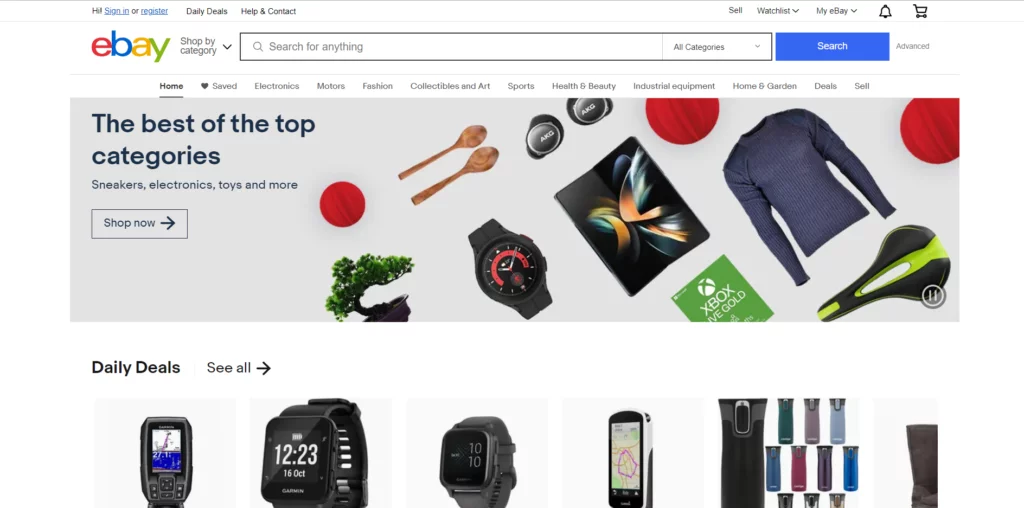
- Established: 1995
- Headquarters: Bay Area, San Francisco, USA
- Monthly unique visitors: 819.46 million visits
Established in 1995, eBay is an American online retailer. They are a global leader in business-to-consumer retail and the top platform for consumers to consumers.
Around 190 countries and territories worldwide are serviced by eBay. Additionally, they have 138 million customers worldwide. On eBay, there are no transaction fees for buyers to pay. For sellers, things are very different because they must pay to list products on the eCommerce platform.
Features
- Listing Items: You may sell on eBay by creating an account and adding things to your catalog. After the first 250 listings, there is a $0.35 per listing non-refundable insertion cost.
- Buy-It-Now: eBay originally functioned as an auction site. They added the Buy-It-Now function, which enables sellers to choose a price while displaying their things, and the auction feature. On their postings that are set up like auctions, sellers can also set the Buy It Now price. The price is placed above the auction price to enable immediate purchase by the buyer.
- eBay Advanced Search: With eBay Advanced Search, customers may focus their searches by using criteria like the number of bids, the price range, and the sale currency.
Pros
- A large audience is accessible to eBay vendors. There is a sizable market on eBay with over 138 million buyers worldwide.
- Since shoppers trust and like eBay, selling on eBay enables you to capitalize on its popularity.
- eBay is a fairly affordable platform, making it user-friendly for buyers and sellers. Two hundred fifty products can be listed for free each month.
Additionally, the final value fee is only assessed after your products have sold.
Cons
- The market is quite competitive. On eBay, almost everything is sold, and many of these things have similar qualities. As a result, to draw in customers, vendors must use various pricing techniques.
- The sellers pay for various extra services, like a bold listing, a larger gallery, a listing in two categories, and a scheduled listing.
AliExpress
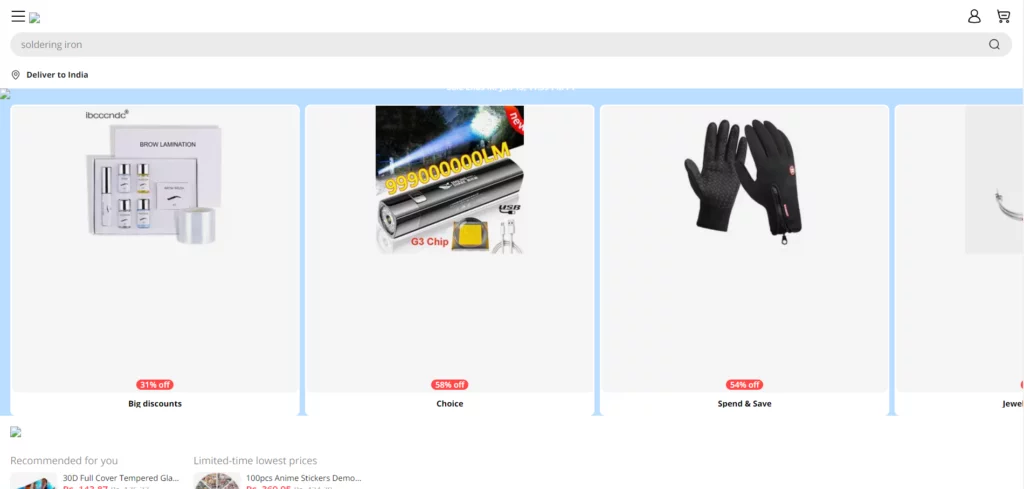
- Established: 2009
- Headquarters: Hangzhou, China
- Monthly unique visitors: 510.93 million visits
The Alibaba group owns the e-commerce website AliExpress It was established in China in 2010. International buyers are the target market, and the vendors are primarily Chinese Customers in mainland China who cannot purchase through AliExpress.
There are 18 language versions of the website, including those in English, Italian, Dutch, Portuguese, Spanish, and French.
Features
- Linguistic Accessibility: There are 18 languages on AliExpress.
- AliDropship is a WordPress and Woocommerce plugin that makes dropshipping from AliExpress easier.
- New sellers on AliExpress can access educational materials through AliExpress University.
Pros
- Cost Effective: Compared to most other e-commerce websites, AliExpress is less expensive Dropshippers will find that AliExpress has the most affordable costs.
- Minimal Overhead: As a dropshipper, AliExpress assists you in lowering your overhead expenses. They let you ship directly to customers, relieving you of the burden of managing inventories.
Cons
- AliExpress’s shipping times are a problem. Their ideal shipment period is 15 days to 2 months. However, several consumers have vehemently criticized the extremely late delivery of their goods.
- Returns and Refunds: On AliExpress, resolving problems can be a real hassle. Returns on AliExpress can take weeks or even longer, and some consumers have even reported not receiving their refunds.
Walmart
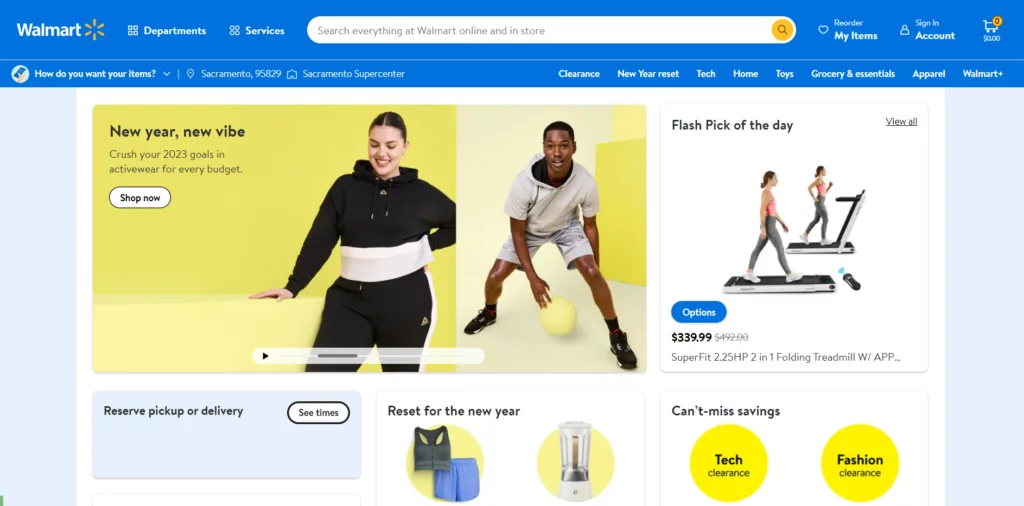
- Established: 1994
- Headquarters: Bentonville, Arkansas
- Monthly unique visitors: 617.19 million visits
In 1962, Walmart, an American international retail chain, was established in Rogers, Arkansas They currently run a variety of eCommerce websites in addition to around 10,500 stores and clubs in about 24 countries. Under various names such as Supercenter, Discount Stores, and Neighborhood Market, Walmart operates in all 50 US States and Puerto Rico.
Walmart is growing to be a significant player in online shopping. Approximately 100 million visitors to their website, walmart.com. Additionally; they have purchased a few e-commerce websites, including jet.com and hayneedle.com.
Walmart is the second-largest retail chain in the world, just behind Amazon, due to the merger of its offline and online activities.
Features
- Walmart Marketplace: It’s a service provided by Walmart in association with Shopify that enables vendors to sell their goods on Walmart.
- To access Walmart Marketplace, sellers need to download Walmart App from the Shopify App Store.
- Users of Walmart Marketplace can use Walmart Fulfillment Services as a fulfillment service.
Pros
- You can sell any product at Walmart if it’s not on the company’s list of forbidden goods.
- Unlike Amazon, Walmart only charges seller fees when your products are purchased, putting no restrictions on the variety of your products. According to the type of product, referral fees vary.
- Walmart lets its vendors design their return procedures.
- Walmart is a one-stop shop for consumers, as there are products of every kind available at Walmart. This aids sellers in creating circumstances that are favorable for their organization.
- Walmart is a less-competitive option. Walmart Marketplace faces far less competition than Amazon, which has over 2 million merchants, with only roughly 70,000 sellers.
Cons
- As there are fewer vendors at Walmart, there are also fewer customers, and Walmart Fulfillment Services has minimal capabilities.
- Walmart has a Price Parity Rule, prohibiting sellers from offering the same product for less money on other eCommerce platforms.
Alibaba
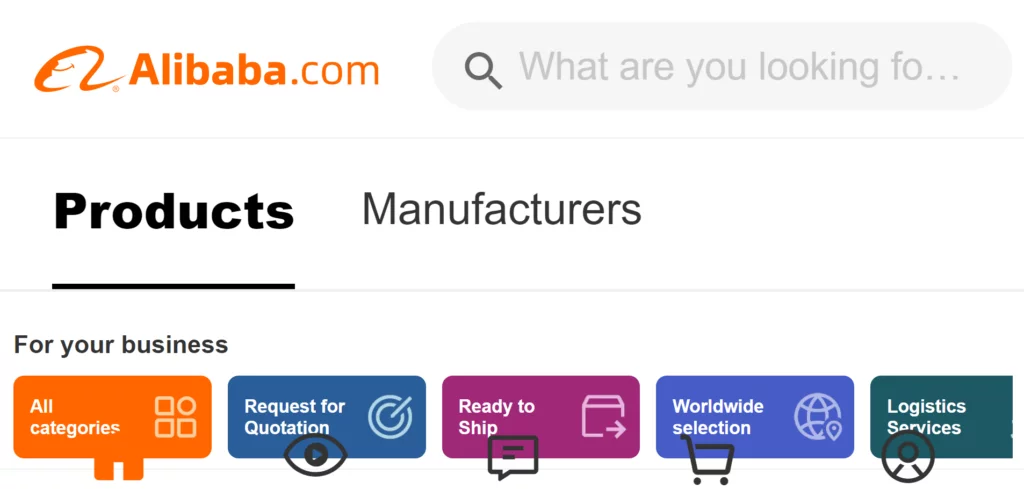
- Established: 1999
- Headquarters: Hangzhou, China
- Monthly unique visitors: 601.45 million visits
Since its establishment in 1999, Alibaba.com has developed into one of the top B2B marketplaces in the world. More than 190 countries and territories are home to buyers, whereas more than 200 are home to sellers. Alibaba has a whopping 40+ product categories and millions of products.
Features
- B2B marketplace: Manufacturers, wholesalers, trading businesses, and exporters are the leading sellers on Alibaba.
- Storefront: On Alibaba, sellers can set up stores without technological knowledge.
- Linguistic Access: Alibaba offers translation services in 18 languages to help vendors communicate with a worldwide customer base.
Pros
- As a buyer business, you have access to thousands of sellers from more than 200 countries.
- Buyer businesses can obtain more flexible terms, such as lower minimum order thresholds, due to the abundance of suppliers.
Cons
- Compared to other eCommerce sites, Alibaba takes longer to ship; between 15 days and months pass.
- Alibaba does not offer dropshipping support.
- Alibaba does not offer a mechanism for buyers making wholesale purchases from overseas companies to perform an on-site visit before their visit.
Before being able to sell on Alibaba, sellers need to have a subscription plan. The Basic Plan is $2,399 annually, while the Premium Plan is $4,199 annually.
JD.com
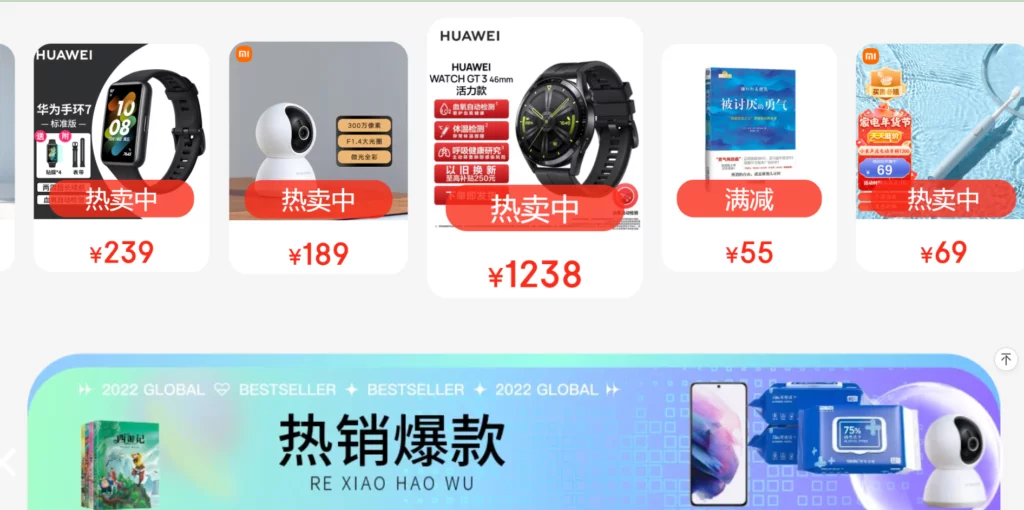
- Established: 2009
- Headquarters: Beijing, China
- Monthly unique visitor: 204.91 million visits
JD.com also referred to as Jingdong in China and Joybuy abroad, is a Chinese e-commerce website established in 2004. It is one of the biggest Chinese online markets, competing with Tmall from Alibaba.
Features
- JD Logistics has a strong reputation in the eCommerce sector for being technologically advanced JD.com offers small and mid-sized businesses warehousing solutions in addition to being an eCommerce store.
- JD Online Store: Foreign vendors may also use JD.com to offer their products in the Chinese market. JD assists the sellers in navigating the convoluted Chinese government authorization process.
Pros
- JD.com is an excellent resource for connecting with Chinese consumers. The business aids foreign vendors in navigating the convoluted process of importing into China.
- The Shopify JD Marketplace makes it simple to sell on JD.com.
Cons
- JD.com store setup can take six to twelve months.
- It has very low ratings and negative reviews on SiteJabber and TrustPilot, and it is a very time-consuming process.
FAQ
1. Which online store has the finest customer service?
The top 4 e-commerce websites in terms of page views, visit length, and bounce rate are Amazon, eBay, Rakuten, and AliExpress.
2. What is the top online retailer?
With an anticipated 2.73 billion monthly visits and a projected global sales of over $469 billion in 2021, Amazon.com is the top online retailer. With an estimated 855.82 million monthly visitors, eBay follows next.Walmart.com, which has 468.96 million monthly visitors, comes next.
3. What is the world’s biggest e-commerce website?
With an anticipated 2.73 billion monthly visitors and a projected global turnover of over $469 billion in 2021, Amazon will be the most popular e-commerce site on the planet.
4. Who is the top online retailer?
With an expected 2.73 billion monthly visits and a global revenue of more than $469 billion in 2021, Amazon is the largest online retailer in the world.
Online shopping gives consumers the more comfortable options they’re looking for when it comes to buying. Customers can shop online from the convenience of their home and purchase anything they want. Due to the rise of online shopping VPN technology providers, you do not have to worry about security in addition to its evident convenience. Your internet connection is protected, preventing Wi-Fi data theft.



